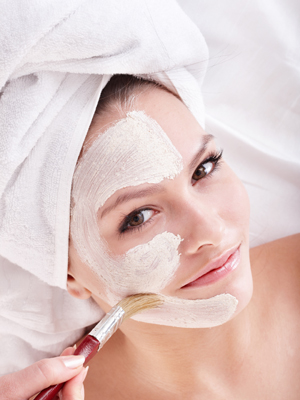Esthetics FAQ’s
Facials
Will I break out after a facial?
Breakouts rarely occur unless your skin is congested with blackheads or whiteheads underneath your skin. If this is the circumstance, you might experience some breakouts, but be assured they won’t last for long.
How often should I have a facial?
We recommend a facial every 4-6 weeks, by means of this frequency we monitor your skin throughout the seasons and help you maintain a healthy and glowing complexion. However, if you are experiencing over stress or menopause your skin can be unpredictable and breakout; your esthetician may recommend more frequent visits until the problem is under control.
Are scrubs bad for my skin?
Some can be, especially shell type particles like almond or apricot kernels scrubs which contain jagged edges and can harm the skin. Most professional exfoliators contain perfect round spheres that will exfoliate your skin without any harm.
At what age should I start receiving regular facials?
Your 20’s to early 30’s are ideal unless you began to experience breakouts at an earlier age. We believe in early skin care education as many teenagers suffer from problem skin that is best addressed early on, having a visit to an esthetician can help treat and correct the problem.
What's the best way to prolong my facial?
Your skin is an investment. You’re going to wear it for the rest of your life. We recommend being diligent with your at home skin regimen like cleansing, exfoliating, moisturizing and protecting.
Is there anything I can do to help my brown spots?
Hyper-pigmentation can occur after sun exposure, pregnancy or taking birth control pills. Yes, there are many treatments available like peels, micro-dermabrasion along with home care programs that will help lighten your pigmentation.
Will I break out after a facial?
Breakouts rarely occur unless your skin is congested with blackheads or whiteheads underneath your skin. If this is the circumstance, you might experience some breakouts, but be assured they won’t last for long.
Lash Extensions
How long do eyelash extensions last?
Most eyelash extension adhesives have a bond time of anywhere from 4-8 weeks. However, they will only last as long as your natural lash does. Like all hair on the human body, your eyelashes grow in stages. It is normal to lose 1-4 natural lashes per day which is why a fill is recommended every 2-4 weeks.
How do I care for my lash extensions?
1. Do not get the lashes wet for the first 24-48 hours including:
-
Steam
-
Tears (boss babes don’t cry
 )
) -
Showering
-
Swimming
-
Eye Makeup Remover
This is crucial to get the best retention possible!
2. Brush your lashes straight as needed, but never when they are wet!
3. No oil based products
4. Do not touch, play with, or pick at your Lashes!
5. Do not use lash curler on them.
How much do lash extensions cost?
The price of lash extensions is based on the fullness of the lash set.
Can I wear eye makeup with my lash extensions?
YES! Although we don’t recommend wearing any mascara that isn’t extension safe or oil based products, as it will shorten the life of your lash extensions.
Will lash extensions damage my natural lashes?
No! When applied properly, with perfect isolation and weight eyelash extensions will not harm your natural lashes.
Our estheticians are trained and experienced, so the most important thing to them is the integrity of your natural lash. During your initial consultation they will evaluate your natural lashes to ensure you get the lashes that work best for your natural lashes so that you will never have damage or breakage.
Waxing
How long should the hair be before I get waxed?
In general, hair needs to be about ¼” long for wax to be able to grab onto it. If it’s not long enough, then our estheticians may not be able to remove it.
Won't the hair grow back thicker and darker?
This is not possible; it’s an old wives tale. Over time with frequent waxing, hair regrowth weakens and comes in finer and thinner, but frequency and diligence is required to achieve results. If hair darkens and grows in thicker, it’s a function of hormones, not waxing.
What about ingrown hairs?
Ingrown hairs may result from the following:
- Genetics: Some clients are prone to ingrown hairs due to their genetic make-up. The esthetician should be consulted to the best follow up care for their clients. This should include some type of exfoliating treatment.
- Tight Clothing: avoid tight clothing after waxing, especially in waxed areas. Tight clothing may result in irritation and ingrown hairs. The client should, after 24-48 hours, use some type of exfoliating product to keep the dead skin build up from accumulating in the areas that tend to become ingrown (i.e., bikini, upper thighs, underarms, back of neck, calves, etc.).
When Not to Wax
- If you recently got a sunless spray tan. Waxing can strip the skin of the sunless color.
- Clients using Retin-A, Renova, Accutane, or any skin exfoliating products such AHA’s and BHA’s
- Vascular problems such as, varicose veins.
- Open wounds, infection, inflammation, hypersensitivity.
- When in doubt, don’t wax!
Is there anything I should avoid after waxing?
Yes! Clients should avoid:
- Outdoor sun exposure for 24 hours
- Make-up if face waxed
- Hot water, saunas
- Deodorant with aluminum
- Chlorinated water
- Tight clothing for legs bikini
- Tanning beds for 24- 48 hours

